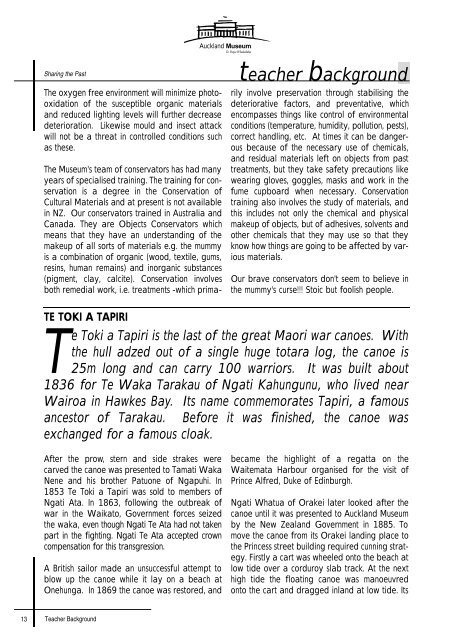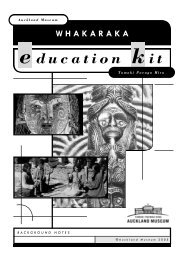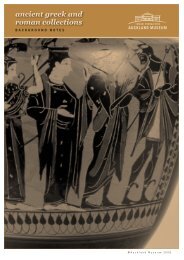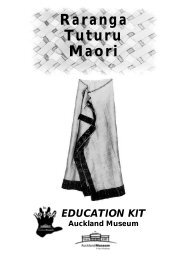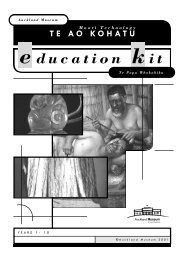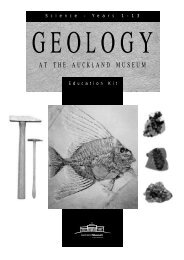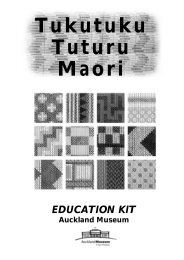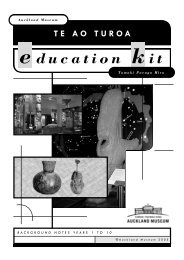Create successful ePaper yourself
Turn your PDF publications into a flip-book with our unique Google optimized e-Paper software.
Sharing <strong>the</strong> Past<br />
The oxygen free environment will minimize photooxidation<br />
of <strong>the</strong> susceptible organic materials<br />
and reduced lighting levels will fur<strong>the</strong>r decrease<br />
deterioration. Likewise mould and insect attack<br />
will not be a threat in controlled conditions such<br />
as <strong>the</strong>se.<br />
The <strong>Museum</strong>'s team of conservators has had many<br />
years of specialised training. The training for conservation<br />
is a degree in <strong>the</strong> Conservation of<br />
Cultural Materials and at present is not available<br />
in NZ. Our conservators trained in Australia and<br />
Canada. They are Objects Conservators which<br />
means that <strong>the</strong>y have an understanding of <strong>the</strong><br />
makeup of all sorts of materials e.g. <strong>the</strong> mummy<br />
is a combination of organic (wood, textile, gums,<br />
resins, human remains) and inorganic substances<br />
(pigment, clay, calcite). Conservation involves<br />
both remedial work, i.e. treatments -which prima-<br />
TE TOKI A TAPIRI<br />
13 Teacher Background<br />
<strong>Auckland</strong> <strong>Museum</strong><br />
Te Papa Whakahiku<br />
rily involve preservation through stabilising <strong>the</strong><br />
deteriorative factors, and preventative, which<br />
encompasses things like control of environmental<br />
conditions (temperature, humidity, pollution, pests),<br />
correct handling, etc. At times it can be dangerous<br />
because of <strong>the</strong> necessary use of chemicals,<br />
and residual materials left on objects from <strong>past</strong><br />
treatments, but <strong>the</strong>y take safety precautions like<br />
wearing gloves, goggles, masks and work in <strong>the</strong><br />
fume cupboard when necessary. Conservation<br />
training also involves <strong>the</strong> study of materials, and<br />
this includes not only <strong>the</strong> chemical and physical<br />
makeup of objects, but of adhesives, solvents and<br />
o<strong>the</strong>r chemicals that <strong>the</strong>y may use so that <strong>the</strong>y<br />
know how things are going to be affected by various<br />
materials.<br />
Our brave conservators don't seem to believe in<br />
<strong>the</strong> mummy's curse!!! Stoic but foolish people.<br />
Te Toki a Tapiri is <strong>the</strong> last of <strong>the</strong> great Maori war canoes. With<br />
<strong>the</strong> hull adzed out of a single huge totara log, <strong>the</strong> canoe is<br />
25m long and can carry 100 warriors. It was built about<br />
1836 for Te Waka Tarakau of Ngati Kahungunu, who lived near<br />
Wairoa in Hawkes Bay. Its name commemorates Tapiri, a famous<br />
ancestor of Tarakau. Before it was finished, <strong>the</strong> canoe was<br />
exchanged for a famous cloak.<br />
After <strong>the</strong> prow, stern and side strakes were<br />
carved <strong>the</strong> canoe was presented to Tamati Waka<br />
Nene and his bro<strong>the</strong>r Patuone of Ngapuhi. In<br />
1853 Te Toki a Tapiri was sold to members of<br />
Ngati Ata. In 1863, following <strong>the</strong> outbreak of<br />
war in <strong>the</strong> Waikato, Government forces seized<br />
<strong>the</strong> waka, even though Ngati Te Ata had not taken<br />
part in <strong>the</strong> fighting. Ngati Te Ata accepted crown<br />
compensation for this transgression.<br />
A British sailor made an unsuccessful attempt to<br />
blow up <strong>the</strong> canoe while it lay on a beach at<br />
Onehunga. In 1869 <strong>the</strong> canoe was restored, and<br />
teacher background<br />
became <strong>the</strong> highlight of a regatta on <strong>the</strong><br />
Waitemata Harbour organised for <strong>the</strong> visit of<br />
Prince Alfred, Duke of Edinburgh.<br />
Ngati Whatua of Orakei later looked after <strong>the</strong><br />
canoe until it was presented to <strong>Auckland</strong> <strong>Museum</strong><br />
by <strong>the</strong> New Zealand Government in 1885. To<br />
move <strong>the</strong> canoe from its Orakei landing place to<br />
<strong>the</strong> Princess street building required cunning strategy.<br />
Firstly a cart was wheeled onto <strong>the</strong> beach at<br />
low tide over a corduroy slab track. At <strong>the</strong> next<br />
high tide <strong>the</strong> floating canoe was manoeuvred<br />
onto <strong>the</strong> cart and dragged inland at low tide. Its


